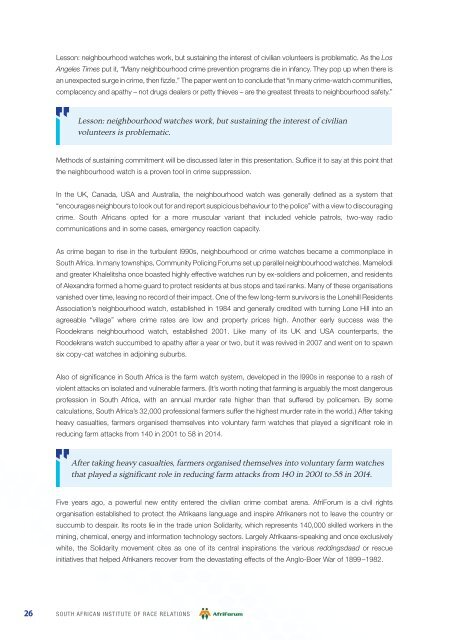2230_SAIRR_WWACinSA_sm4.indd 1 2016/09/05 5:04 PM
sairr_english_wwacinsa_print_050916
sairr_english_wwacinsa_print_050916
Create successful ePaper yourself
Turn your PDF publications into a flip-book with our unique Google optimized e-Paper software.
Lesson: neighbourhood watches work, but sustaining the interest of civilian volunteers is problematic. As the Los<br />
Angeles Times put it, “Many neighbourhood crime prevention programs die in infancy. They pop up when there is<br />
an unexpected surge in crime, then fi zzle.” The paper went on to conclude that “in many crime-watch communities,<br />
complacency and apathy – not drugs dealers or petty thieves – are the greatest threats to neighbourhood safety.”<br />
Lesson: neighbourhood watches work, but sustaining the interest of civilian<br />
volunteers is problematic.<br />
Methods of sustaining commitment will be discussed later in this presentation. Suffi ce it to say at this point that<br />
the neighbourhood watch is a proven tool in crime suppression.<br />
In the UK, Canada, USA and Australia, the neighbourhood watch was generally defi ned as a system that<br />
“encourages neighbours to look out for and report suspicious behaviour to the police” with a view to discouraging<br />
crime. South Africans opted for a more muscular variant that included vehicle patrols, two-way radio<br />
communications and in some cases, emergency reaction capacity.<br />
As crime began to rise in the turbulent l990s, neighbourhood or crime watches became a commonplace in<br />
South Africa. In many townships, Community Policing Forums set up parallel neighbourhood watches. Mamelodi<br />
and greater Khalelitsha once boasted highly effective watches run by ex-soldiers and policemen, and residents<br />
of Alexandra formed a home guard to protect residents at bus stops and taxi ranks. Many of these organisations<br />
vanished over time, leaving no record of their impact. One of the few long-term survivors is the Lonehill Residents<br />
Association’s neighbourhood watch, established in 1984 and generally credited with turning Lone Hill into an<br />
agreeable “village” where crime rates are low and property prices high. Another early success was the<br />
Roodekrans neighbourhood watch, established 2001. Like many of its UK and USA counterparts, the<br />
Roodekrans watch succumbed to apathy after a year or two, but it was revived in 2007 and went on to spawn<br />
six copy-cat watches in adjoining suburbs.<br />
Also of signifi cance in South Africa is the farm watch system, developed in the l990s in response to a rash of<br />
violent attacks on isolated and vulnerable farmers. (It’s worth noting that farming is arguably the most dangerous<br />
profession in South Africa, with an annual murder rate higher than that suffered by policemen. By some<br />
calculations, South Africa’s 32,000 professional farmers suffer the highest murder rate in the world.) After taking<br />
heavy casualties, farmers organised themselves into voluntary farm watches that played a signifi cant role in<br />
reducing farm attacks from 140 in 2001 to 58 in 2014.<br />
After taking heavy casualties, farmers organised themselves into voluntary farm watches<br />
that played a significant role in reducing farm attacks from 140 in 2001 to 58 in 2014.<br />
Five years ago, a powerful new entity entered the civilian crime combat arena. AfriForum is a civil rights<br />
organisation established to protect the Afrikaans language and inspire Afrikaners not to leave the country or<br />
succumb to despair. Its roots lie in the trade union Solidarity, which represents 140,000 skilled workers in the<br />
mining, chemical, energy and information technology sectors. Largely Afrikaans-speaking and once exclusively<br />
white, the Solidarity movement cites as one of its central inspirations the various reddingsdaad or rescue<br />
initiatives that helped Afrikaners recover from the devastating effects of the Anglo-Boer War of 1899 –1982.<br />
26<br />
SOUTH AFRICAN INSTITUTE OF RACE RELATIONS<br />
<strong>2230</strong>_<strong>SAIRR</strong>_<strong>WWACinSA</strong>_<strong>sm4.indd</strong> 26<br />
<strong>2016</strong>/<strong>09</strong>/<strong>05</strong> 5:<strong>04</strong> <strong>PM</strong>


